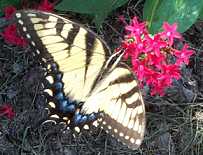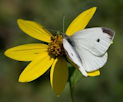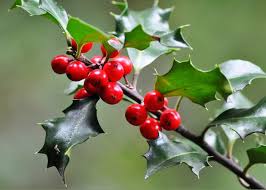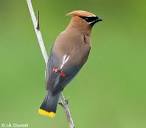Gardenesque
Plants  Design Information
Design Information  Clay Soils
Clay Soils  Harford County, MD
Harford County, MD
Wildlife Gardening . . .
Listed here are articles from previous newsletters on gardening to attract wildlife. If you would like to learn more about one of these topics, please click on its link shown below.
Attracting Songbirds to your Garden
Cedar Waxwings
Butterfly Gardening
When I ask my clients if there are any special plants they want in their gardens, they usually mention plants that attract birds and butterflies. Actually, when I first started landscaping my property many years ago, that's what I wanted too.>/p>
While I was designing my garden, I read many books on how to attract birds to our gardens and followed their advice. Over the years I've been blessed with many bird friends--either those that stay year-round or those that visit in the winter.
 I don't think I ever read a book about butterfly gardening. Usually, there might be a chapter or two about this subject in a book on wildlife gardening or a magazine article. Recently though, I've noticed many videos and books devoted solely to butterfly gardening and while researching this article I found much information on the web as well.
I don't think I ever read a book about butterfly gardening. Usually, there might be a chapter or two about this subject in a book on wildlife gardening or a magazine article. Recently though, I've noticed many videos and books devoted solely to butterfly gardening and while researching this article I found much information on the web as well.
Over the years I've enjoyed sitting in my chair on the terrace and watching the butterflies flutter around the garden. But it wasn't until last fall that I realized how special a garden becomes when there are many butterflies in it. I realized this when I visited Chanticleer Gardens in September. We were at Chanticleer's pond and there were hundreds of butterflies of many different Species among the flowers growing around the pond. That evening was magical. The butterflies were feeding on asters, Joe Pye weed, goldenrod, black-eyed Susan, Verbena bonariensis, Phlox and many, many other flowers.
To attract butterflies, I've always recommended the following:
- Buddleia, the butterfly bush, as well as
- Salvia,
- Asclepias or milkweed,
- Echinacea or purple coneflower,
- Joe Pye weed,
- Asclepias incarnata or swamp milkweed,
- Liatris or blazing star,
- Monarda or beebalm,
- all of the rudbeckias, and
- Solidago or goldenrod.
 That day at Chanticleer I noticed a native perennial called Vernonia or ironweed attracted a variety of lovely butterflies including the Tiger Swallowtail. Vernonia is tall growing--to 4 to 6 feet tall. It has narrow, dark green leaves and little pincushion-type flowers in a lovely purple-violet color. It is narrow growing--to about two feet wide. Late last year I planted Vernonia novaboriensis 'Richard Simon' and it's as beautiful as the ones at Chanticleer and even more so. The color of ‘Richard Simon' seems to glow from within so that even though its color is dark it still stands out even from a distance. Now I can watch the many butterflies up close as they fly from flower to flower and drink the nectar from them. They do seem to stay a while and drink fully.
That day at Chanticleer I noticed a native perennial called Vernonia or ironweed attracted a variety of lovely butterflies including the Tiger Swallowtail. Vernonia is tall growing--to 4 to 6 feet tall. It has narrow, dark green leaves and little pincushion-type flowers in a lovely purple-violet color. It is narrow growing--to about two feet wide. Late last year I planted Vernonia novaboriensis 'Richard Simon' and it's as beautiful as the ones at Chanticleer and even more so. The color of ‘Richard Simon' seems to glow from within so that even though its color is dark it still stands out even from a distance. Now I can watch the many butterflies up close as they fly from flower to flower and drink the nectar from them. They do seem to stay a while and drink fully.
As Vernonia is a tall plant it belongs in the back of the border but if it is in the back of the border how can I see the butterflies up close? I planted it in the back but near a path in the bed. Vernonia works well with Solidago or goldenrod and with Rudbeckia or black-eyed Susan. It requires sun and moist, slightly acid soil. The plant can be cut back by half when it is two feet tall and it will bloom at a shorter height.
Some garden writers have written that Vernonia is not a first-rate garden plant. I don't understand why. It has nice leaves and flowers at a time when little else is in bloom and it attracts Swallowtail butterflies. I did notice that after flowering its lower leaves turn brown; therefore, plant goldenrod in front of it to cover up its bare legs. During the winter, its seedheads are fluffy white and are very noticeable even from a distance. I think it is a nice background plant for the perennial garden or for the mixed border and I urge you to try it in your garden..
Some other plants for a butterfly garden are:
- Abelia grandiflora--Glossy Abelia
- Vitex agnus castus--Chaste tree
- Koelrueteria paniculata--Goldenrain tree
- Cosmos sulphureus--annual cosmos
- Lantana camara--annual lantana
Butterflies drink the nectar from all of the above plants. Monarch butterflies use the milkweed as a host plant to lay eggs  for its caterpillars. Fritillary butterflies use the passion flower vine, Passiflora, as its host plant. I understand that parsley, chives, dill, and butterfly weed can be planted to provide food for many species of butterflies such as the black swallowtail.
for its caterpillars. Fritillary butterflies use the passion flower vine, Passiflora, as its host plant. I understand that parsley, chives, dill, and butterfly weed can be planted to provide food for many species of butterflies such as the black swallowtail.
The butterfly garden is best situated in sun and in a place protected from the wind. There should also be a variety of shrubs for them to use to rest and to roost. Butterfly gardening helps us to see the need to grow native plants. Without the native plants we won't have butterflies. Here is a short list of butterfly websites.
NABA (North American Butterfly Assn)
Back to the Top
Attracting Songbirds to your Garden
As a landscape designer and garden consultant, I've noticed that many of my clients want their gardens to attract a variety of song birds. This need for us to interact with the natural world is a wonderful opportunity for us to get to know our environment. As each of our gardens is a part of nature, it's important that it provide cover, food, shelter, and water for birds in summer and winter. Nothing beats the winter doldrums better than opening up the window curtains on a cold, frosty morning and finding many kinds of birds at our feeders and in our gardens.
An excellent book that's that's still available is "Songbirds in your Garden" by John K. Terres. I used it as a reference when I developed my landscape design for my own property many years ago. It has excellent information on the many plants that attract specific songbirds to the garden. The Harford County Library has many books that can help you to get started or to improve your skills at birdwatching or bird attracting. Of course, you can find much information on the web as well.
Many of the larger trees and shrubs which are the bones of the garden are usually excellent bird attractors and help birds survive through the winter by providing roosting space. Some, such as the hemlock, spruce, yew, fir, and pine provide cover on cold, winter nights. I don't usually like to suggest large trees for half acre or smaller lots but the large trees work very well as corner markers or screens along the back property line.
 Many birds relish the fruits of holly, barberry, crabapple, mountain ash, and hawthorn right through the winter and into the spring nesting period. Fruits are messy when the trees are planted near sidewalks, driveways, and decks; so, plant fruit-bearing trees away from these areas. Birds are even more likely to visit them if the trees are not so close to where humans might visit. Birds also eat the seeds of pine, hemlock, spruce and other trees and shrubs in the winter.
Many birds relish the fruits of holly, barberry, crabapple, mountain ash, and hawthorn right through the winter and into the spring nesting period. Fruits are messy when the trees are planted near sidewalks, driveways, and decks; so, plant fruit-bearing trees away from these areas. Birds are even more likely to visit them if the trees are not so close to where humans might visit. Birds also eat the seeds of pine, hemlock, spruce and other trees and shrubs in the winter.
Viburnum, serviceberry, and the other fruit-bearing plants provide fruits for the summer nesting birds. Their fruits are eaten as soon as they ripen so we humans don't get much chance to enjoy their colorful fruits, but we can watch the birds as they zoom in and out of the shrubs on their hectic feeding schedules.
Some plants that I think work especially well in Harford County and surrounding areas and are also great bird attractors are listed below. Next to the plant name, I've listed some of the popular songbirds that they attract.
On a new home site with no or only small trees, some of the birds listed above may never be seen, such as the Towhee and Tanager, because they usually live in the woods. Other birds, such as the Bluebird, will welcome bluebird houses in new subdivisions because they like open spaces. Many of the bird guides, such as the "Audubon Land Bird Guide", will not only have pictures and descriptions of the birds but will also tell you where you are most likely to find them, be it in the woods, along streams, or in meadows. Over the years, as your landscape and garden plantings mature, the types of birds visiting your garden will change too. Perhaps at the beginning you had bluebird boxes full of baby bluebirds, but as the trees grow, perhaps now you may have Scarlet Tanagers feeding in the treetops. Here's a short list about attacting songbirds to your garden.
Plant Botanical
Name
Plant Common Name
Names of Birds
Acer rubrum
Red Maple
Chickadee, Purple Finch, Goldfinch, Grosbeak, Nuthatch
Amelanchier
Serviceberry
Bluebird, Catbird, Chickadee, Grosbeak, Jay, Oriole, Robin, Tanager, Thrush, Towhee, Cedar Waxwing, Woodpecker
Cornus
Dogwood species
Bluebird, Cardinal, Catbird, Grosbeak, Kingbird, Robin, Tree Swallow, Tanager, Thrush, Vireo, Warbler, Cedar Waxwing, Woodpecker
Fagus
Beech
Grosbeak, Jay, Nuthatch, Titmouse, Woodpecker
Ilex glabra, Ilex opaca, Ilex pedunculosa, Ilex verticillata
Native holly species
Bluebird, Catbird, Robin, Thrush, Towhee, Vireo, Cedar Waxwing, Woodpecker
Nyssa sylvatica
Black Gum
Purple Finch, Robin, Tanager, Thrush, Cedar Waxwing, Woodpecker
Picea
Spruce species
Chickadee, Crossbill, Grosbeak, Nuthatch, Cedar Waxwing, Woodpecker
Pinus strobus
White Pine
Chickadee, Crossbill, Grosbeak, Jay, Junco, Nuthatch, Titmouse, Towhee, Warbler, Woodpecker, Carolina Wren
Quercus
Oak species
Chickadee, Grosbeak, Jay, Nuthatch, Titmouse, Towhee, Woodpecker
Attracting Songbirds to Your Garden
Back to the Top
Cedar Waxwings
Many years ago when we first moved to Bel Air, Maryland there was a standard apple tree on the property next to us. I remember seeing flocks of fast moving, twittering birds with a crest similar to the cardinal's crest eating the fruit. I only saw them once or twice during that winter.
Two winters ago while I was walking with my dog in an area that has several ornamental crabapple trees, I noticed a large flock of birds moving quickly in and out among the trees. The sound they made was a high-pitched twittering. They were moving so fast I wasn't sure what they were but I thought I saw a crest or two and as they were small and brownish I thought they might be Cedar Waxwings.
 I saw another flock last year enjoying the fruits of the same crabapples. As they flew I noticed their yellow bellies which the Audubon Bird Guide calls "flanks". I then saw them in my own garden eating the fruits of the many different hollies we've planted over the years.
I saw another flock last year enjoying the fruits of the same crabapples. As they flew I noticed their yellow bellies which the Audubon Bird Guide calls "flanks". I then saw them in my own garden eating the fruits of the many different hollies we've planted over the years.
At this time, my property has many types of hollies. Ilex x meserveae and Ilex attentuata 'Fosteri' are used as screens. Ilex x meserveae 'Blue Prince' and 'Blue Princess' are used as ground covers and as edging plants on the back edges of the large bed. Ilex x meserveae 'Blue Angel' is used as an accent plant in the beds.
Besides the hollies listed above, Cedar Waxwings also enjoy the fruits or seeds of Serviceberry (Amelanchier spp.), Dogwoods (Cornus spp.), including the shrubby dogwoods, Black Gum (Nyssa sylvatica), and the many Spruces (Picea). They usually don't comes to bird feeders, but they might be enticed to come to a platform-type feeder filled with chopped or sliced apples and raisins or currants.
In this area Cedar Waxwings are winter visitors as they nest in the northern states and Canada. During June I saw Cedar Waxwings in the garden of Innisfree near Poughkeepsie, New York. They were again in a large flock, flying high overhead among the trees gathering insects in mid June.
If you want to learn more about Cedar Waxwings and the many different birds that migrate to this area during the winter, this site might help.